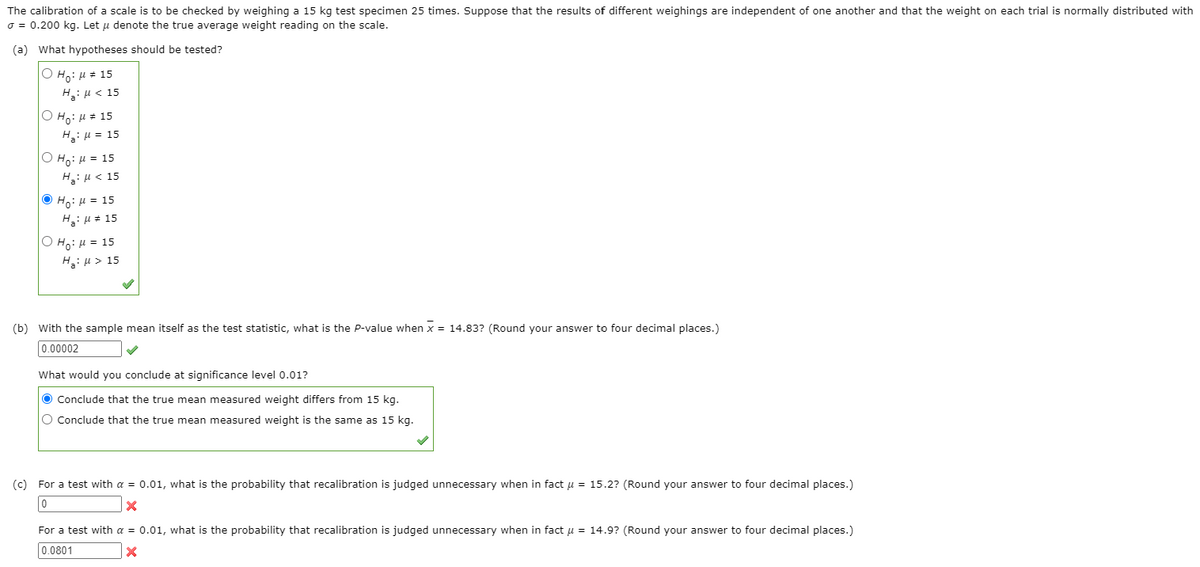The calibration of a scale is to be checked by weighing a 15 kg test specimen 25 times. Suppose that the results of different weighings are independent of one another and that the weight on each trial is normally distributed with o = 0.200 kg. Let u denote the true average weight reading on the scale. (a) What hypotheses should be tested? O Hoi H= 15 ST > H :°H O Ho: H = 15 HiH = 15 O Hoi H = 15 H:H< 15 O Ho: H = 15 H: µ = 15 O Hoi H = 15 HgiH> 15 (b) With the sample mean itself as the test statistic, what is the P-value when x = 14.83? (Round your answer to four decimal places.) 0.00002 What would you conclude at significance level 0.01? O Conclude that the true mean measured weight differs from 15 kg. O Conclude that the true mean measured weight is the same as 15 kg. (c) For a test with a = 0.01, what is the probability that recalibration is judged unnecessary when in fact µ = 15.2? (Round your answer to four decimal places.) For a test with a = 0.01, what is the probability that recalibration is judged unnecessary when in fact u = 14.9? (Round your answer to four decimal places.) 0.0801
The calibration of a scale is to be checked by weighing a 15 kg test specimen 25 times. Suppose that the results of different weighings are independent of one another and that the weight on each trial is normally distributed with o = 0.200 kg. Let u denote the true average weight reading on the scale. (a) What hypotheses should be tested? O Hoi H= 15 ST > H :°H O Ho: H = 15 HiH = 15 O Hoi H = 15 H:H< 15 O Ho: H = 15 H: µ = 15 O Hoi H = 15 HgiH> 15 (b) With the sample mean itself as the test statistic, what is the P-value when x = 14.83? (Round your answer to four decimal places.) 0.00002 What would you conclude at significance level 0.01? O Conclude that the true mean measured weight differs from 15 kg. O Conclude that the true mean measured weight is the same as 15 kg. (c) For a test with a = 0.01, what is the probability that recalibration is judged unnecessary when in fact µ = 15.2? (Round your answer to four decimal places.) For a test with a = 0.01, what is the probability that recalibration is judged unnecessary when in fact u = 14.9? (Round your answer to four decimal places.) 0.0801
Glencoe Algebra 1, Student Edition, 9780079039897, 0079039898, 2018
18th Edition
ISBN:9780079039897
Author:Carter
Publisher:Carter
Chapter10: Statistics
Section10.1: Measures Of Center
Problem 9PPS
Related questions
Question

Transcribed Image Text:The calibration of a scale is to be checked by weighing a 15 kg test specimen 25 times. Suppose that the results of different weighings are independent of one another and that the weight on each trial is normally distributed with
o = 0.200 kg. Let u denote the true average weight reading on the scale.
(a) What hypotheses should be tested?
Ο Hg: μ + 15
H: H < 15
Ο H: μ + 15
Hg:H = 15
Ο H9: μ= 15
H,: μ< 15
Ο H: μ= 15
H: H = 15
Ο H: μ= 15
H: H > 15
(b) with the sample mean itself as the test statistic, what is the P-value when x = 14.83? (Round your answer to four decimal places.)
0.00002
What would you conclude at significance level 0.01?
O Conclude that the true mean measured weight differs from 15 kg.
O Conclude that the true mean measured weight is the same as 15 kg.
(c) For a test with a = 0.01, what is the probability that recalibration is judged unnecessary when in fact u = 15.2? (Round your answer to four decimal places.)
For a test with a = 0.01, what is the probability that recalibration is judged unnecessary when in fact u = 14.9? (Round your answer to four decimal places.)
0.0801
Expert Solution
This question has been solved!
Explore an expertly crafted, step-by-step solution for a thorough understanding of key concepts.
This is a popular solution!
Trending now
This is a popular solution!
Step by step
Solved in 6 steps

Recommended textbooks for you

Glencoe Algebra 1, Student Edition, 9780079039897…
Algebra
ISBN:
9780079039897
Author:
Carter
Publisher:
McGraw Hill

Glencoe Algebra 1, Student Edition, 9780079039897…
Algebra
ISBN:
9780079039897
Author:
Carter
Publisher:
McGraw Hill